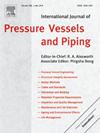Can air carbon arc gouging sensitize stabilized or low-carbon austenitic stainless steel?
IF 3
2区 工程技术
Q2 ENGINEERING, MECHANICAL
International Journal of Pressure Vessels and Piping
Pub Date : 2025-05-09
DOI:10.1016/j.ijpvp.2025.105555
引用次数: 0
Abstract
This paper challenges the widespread skepticism surrounding the use of air carbon arc gouging (ACAG) in repair welding for critical applications in stainless steels, such as oil and gas assets, by evaluating its effects on the electrochemical properties of AISI 316L and AISI 321 austenitic stainless steels. This investigation examines the degree of sensitization and intergranular corrosion susceptibility in a simulated repair scenario. The experimental setup involved creating a gouged groove (6–7 mm depth) adjacent to the heat-affected zone (HAZ) using air carbon arc gouging (ACAG), followed by rewelding via submerged arc welding (SAW). Welded joints were analyzed under three surface preparation conditions after gouging: i) no cleaning, ii) brushing, and iii) rectifying. Electrochemical evaluation was conducted using the double loop potentiokinetic reactivation (DL-EPR) technique in accordance with ISO 12732:2017, while susceptibility to intergranular corrosion was assessed using ASTM A262-15, Practice A, oxalic acid etching tests. The results debunk the prevailing assumption that ACAG inevitably compromises the corrosion resistance of stainless steels. They demonstrate that, even without post-process cleaning, the procedure does not increase sensitization or susceptibility to intergranular attack. These findings validate ACAG as a viable, efficient, and cost-effective method for repair welding in low-carbon or stabilized austenitic stainless steels, simulating field conditions. This includes demanding industries such as oil and gas, where it ensures effective defect removal and full weld penetration while preserving asset integrity and resistance to localized corrosion.
空气碳弧气刨能敏化稳定或低碳奥氏体不锈钢吗?
本文通过评估空气碳气弧焊(ACAG)对AISI 316L和AISI 321奥氏体不锈钢电化学性能的影响,挑战了人们对在石油和天然气资产等不锈钢关键应用的修复焊接中使用ACAG的普遍怀疑。本研究考察了在模拟修复场景中的敏化程度和晶间腐蚀敏感性。实验设置包括使用空气碳弧刨(ACAG)在热影响区(HAZ)附近创建一个刨槽(6 - 7mm深),然后通过埋弧焊(SAW)重新焊接。焊接接头在三种表面处理条件下进行分析:1)不清洗,2)刷焊,3)整流。根据ISO 12732:2017,采用双回路电位动力学再激活(DL-EPR)技术进行电化学评价,采用ASTM A262-15实践A草酸蚀刻试验评估晶间腐蚀敏感性。结果揭穿了普遍的假设,即ACAG不可避免地损害不锈钢的耐腐蚀性。他们证明,即使没有后处理清洗,该程序也不会增加致敏性或对晶间攻击的易感性。这些研究结果验证了ACAG是一种可行、高效、经济的方法,可以模拟现场条件,用于低碳或稳定奥氏体不锈钢的修复焊接。这包括石油和天然气等要求苛刻的行业,在这些行业中,它可以确保有效地去除缺陷和完全焊接,同时保持资产的完整性和抗局部腐蚀。
本文章由计算机程序翻译,如有差异,请以英文原文为准。
求助全文
约1分钟内获得全文
求助全文
来源期刊
CiteScore
5.30
自引率
13.30%
发文量
208
审稿时长
17 months
期刊介绍:
Pressure vessel engineering technology is of importance in many branches of industry. This journal publishes the latest research results and related information on all its associated aspects, with particular emphasis on the structural integrity assessment, maintenance and life extension of pressurised process engineering plants.
The anticipated coverage of the International Journal of Pressure Vessels and Piping ranges from simple mass-produced pressure vessels to large custom-built vessels and tanks. Pressure vessels technology is a developing field, and contributions on the following topics will therefore be welcome:
• Pressure vessel engineering
• Structural integrity assessment
• Design methods
• Codes and standards
• Fabrication and welding
• Materials properties requirements
• Inspection and quality management
• Maintenance and life extension
• Ageing and environmental effects
• Life management
Of particular importance are papers covering aspects of significant practical application which could lead to major improvements in economy, reliability and useful life. While most accepted papers represent the results of original applied research, critical reviews of topical interest by world-leading experts will also appear from time to time.
International Journal of Pressure Vessels and Piping is indispensable reading for engineering professionals involved in the energy, petrochemicals, process plant, transport, aerospace and related industries; for manufacturers of pressure vessels and ancillary equipment; and for academics pursuing research in these areas.

 求助内容:
求助内容: 应助结果提醒方式:
应助结果提醒方式:


